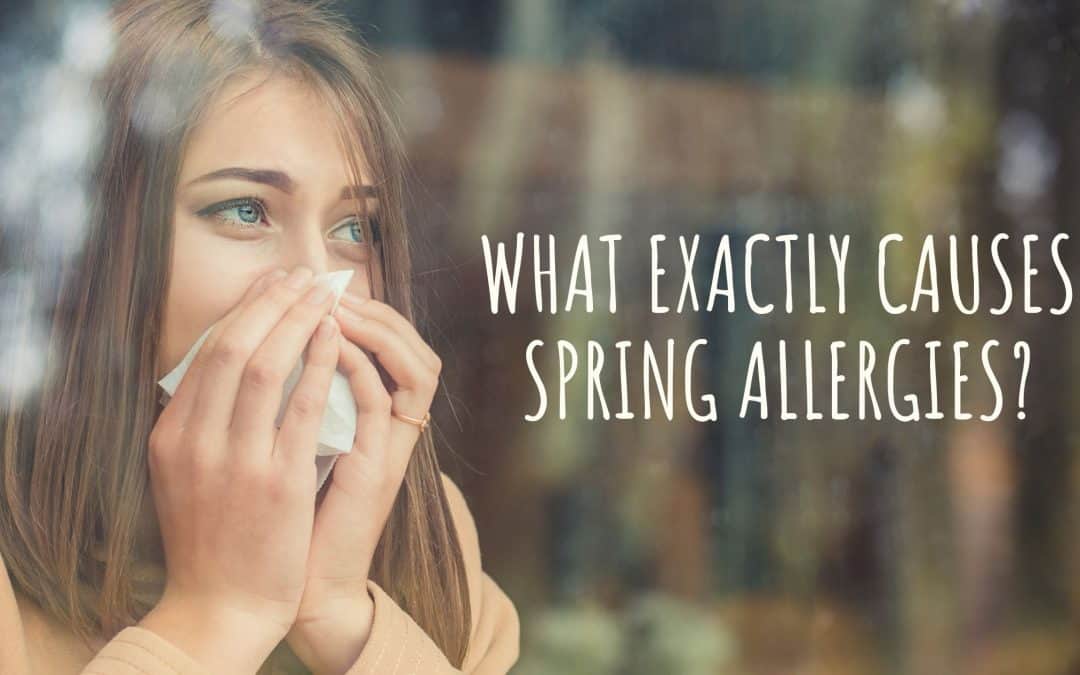Spring is in full swing! Many of us look forward to this time of year: warmer weather, bluer skies, and more sun. Though Spring ushers in much to be excited about, it is also often characterized as “allergy season”!
According to the American Academy of Allergy, Asthma & Immunology, nearly 10% of the population experiences seasonal allergies. The most common spring allergy symptoms include: sneezing, itchy and/or watery eyes, congestion, and a scratchy throat. These symptoms can be experienced daily and throughout the Spring, creating discomfort as you navigate daily life. Spring allergies are also called hay fever. Understanding Spring allergies and ways you can effectively manage symptoms can drastically alleviate its impact.
Common Spring Allergy Triggers
Spring, or seasonal allergies, is also known as allergic rhinitis. Allergic rhinitis is caused by the body’s immune system reacting to a particular substance that activates a specific response system. This substance is referred to as an allergen which people can come into contact with in a variety of ways: touching, ingesting, breathing in etc. The most common substances that are allergens include pollen, tree pollen, and mold spores. Pollen is made by plants and used to fertilize other plants. During the Spring and Summer, pollen is at its highest. This is what makes Spring allergies common and consistently experienced through the season. Warmer temperatures and drier days allow pollen to stay in the environment longer which increases peoples’ exposure, triggering their allergies. Mold spores can also be present both indoors and outdoors, particularly in damp areas like fallen leaves and basements, leading to symptoms like sneezing and a runny nose. Spring allergies causes involve the release of pollen from trees and grasses, triggering a biological response where the immune system produces histamine, leading to common allergy symptoms.
Spring allergies are activated when the immune system identifies the allergen (i.e. pollen) as potentially harmful to the body. This misidentification then causes the immune system to release antibodies to neutralize the substance – preventing it from threatening the body and overall health. Every time a person comes into contact with the allergen, these antibodies detect the substance and release chemicals including histamine into the bloodstream. This (over) reaction then causes the symptoms we commonly associate with allergies: runny nose, sneezing, nasal congestion, irritated eyes, itchy skin etc.
Allergy Symptoms and Treatment
There are a variety of useful ways to treat Spring allergies but there are no cures that permanently prevent the allergic reaction. Allergy symptoms can be effectively managed through over the counter medications and self-managed strategies. There are numerous types of nonprescription medications that are commonly used to alleviate symptoms including the following:
-
- Antihistamines taken orally to provide relief from the most common symptoms of allergies. Popular types of antihistamines include: Claritin, Zyrtec, and Allegra.
- Decongestants targets and alleviates nasal congestion. Decongestants can come in forms taken orally or via nasal spray.
- Nasal Spray alleviates nasal congestion and pressure in the nose.
- People often combine antihistamines with decongestants as well as natural remedies. At home strategies can include:
- Rinsing nasal pathways with saline solution to alleviate congestion. You can do this using a neti pot or squeeze bottle. This can drain accumulated mucus and allergens in your nasal pathways.
- Steaming steam from a machine or humidifier can also alleviate pressure by softening and clearing mucus.
- Drinking tea, herbal mixtures, raw honey to treat sore or itchy throat.
In addition to these treatment options, there are additional practices you can integrate into your daily life to minimize your experience with Spring allergies.
For those with serious allergy cases, allergy shots can be a long-term immunotherapy solution. These injections aim to desensitize individuals to specific allergens over a treatment period of 3 to 5 years, resulting in reduced allergic reactions and improved quality of life for those suffering from allergies.
Useful Tips to Alleviate Spring Allergies
It is important to take the time to explore and discover the combination of strategies that works best for you. This also includes strategies to reduce your exposure to allergens which you can do in a variety of ways:
-
- Know the pollen count! Allergies will be more intense when there is more pollen in the air. To know current and projected levels of pollen, check the forecast. If pollen is expected to be high, be sure to take medications in advance.
- Understanding the spring allergy season and its typical duration is crucial. This season often begins in early spring and can last until late summer, with tree and grass pollen being common triggers.
- Avoid being outside when pollen is high. This includes in the morning when pollen tends to be pervasive and on windy days (wind spreads pollen).
- You can also reduce your exposure by limiting outdoor activities – exercising, sitting, gardening, mowing the lawn, etc.
- Remove clothes worn outside when you are back in your own space.
- Keep the air indoors as purified as possible by vacuuming frequently, using a dehumidifier, regularly replace air conditioning filters etc.
- Diagnosing seasonal allergies is essential for effective management. Consult a healthcare provider for appropriate testing, such as skin tests or allergen-specific blood tests, to identify specific allergens and confirm the type of pollen causing your allergies.
Our specialists at Enticare are here to help! Contact us today to find the routine and strategies that provide the most relief for you.

